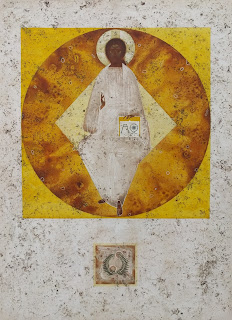'Christ being lifted up': rejoicing in the light of the Ascension
At Choral Communion on The Ascension Day, 2024
Ephesians 1:20
“God put this power to work in Christ when he raised him from the dead and seated him at his right hand in the heavenly places.”
A Thursday evening in early May in our parish church may seem rather different to the festive joys of Easter Day.
We are rather less full than we were on Easter Day. After the penitential season of Lent and the sombre observance of Good Friday, we greeted the colour, the flowers, the light of Easter Day; by Ascension Day, however, we are well used to the colour and light of Eastertide. The choir are, as always, in fine form but the joyous, triumphant music of Ascension Day rarely reaches the same number of hearts as it does on Easter Day.
Most people in our society will be aware that Easter Day is a significant Christian festival, marked by a public holiday. There is, however, no public holiday associated with Ascension Day in the United Kingdom: it is merely a Thursday in early May.
And yet, despite all that, here we are, gathered in our parish church on this Thursday evening in early May, for a service of Choral Communion, with readings from Scripture, prayers, hymns, and music which mark this day as a high holy day, a principal festival of the Christian Church.
Ascension Day may be lacking the cultural and social markers of Easter Day, but, for the Christian Church, it is a day inextricably linked to and fundamentally related to Easter Day.
Easter Day without Ascension Day might leave us gazing at an empty tomb, wondering what it all could mean. Ascension Day reveals the meaning and purpose of Easter Day. The Ascension of Christ reveals God’s purposes for humanity in the Resurrection of Jesus.
This inextricable, fundamental relationship between Easter Day and Ascension Day is seen in the words of the Apostle Paul from our epistle reading: “God put this power to work in Christ when he raised him from the dead and seated him at his right hand in the heavenly places” [1].
God’s power, reconciling humanity, restoring us to communion with our Creator, is revealed and manifested in the Resurrection and Ascension of Jesus: two events but the same act, with the same purpose.
To behold Christ ascending to God the Father, bearing our human nature, is to behold the meaning of the triumph of Easter Day: all the forces of darkness and death and hell are overcome in the Resurrection of Jesus, no longer holding and defining us.
This is what Ascension Day manifests and proclaims. This is the Christian hope: that, in Christ risen and ascended, we are renewed, reconciled, restored to communion with the God who is Life and Light.
Later in this service, as The Great Thanksgiving is offered over the bread and wine of the Holy Communion, we will say, “we celebrate his resurrection and ascension” [2].
Both events stand together, the same power and purpose of God at work in each, delivering us from life apart from God, restoring us to the hope and promise of the fullness of life in God.
And so, we are gathered in our parish church on a Thursday evening in early May, because the Ascension Day is the fulfilment of Easter Day, revealing the meaning for us of the Resurrection of Christ; proclaiming why the heart of Christianity is confessing faith in the Resurrection.
One of the great theologians of our Anglican tradition, Jeremy Taylor, said that the Ascension shows us that from God’s “glorious presence we cannot be kept by the change of death, and the powers of the grave, nor the depth of hell, nor the height of heaven, but Christ being lifted up, shall draw all his servants unto him" [3].
So may the festive joy of this Ascension Day draw us in heart, mind, and soul more deeply, in and through the ascended Christ, into the life-giving glory of the God who is Light eternal.
----------
[1] Ephesians 1:15-23 is provided as the epistle reading for The Ascension Day in BCP 2004, when Acts 1:1-11 is the first reading.
[2] BCP 2004, Holy Communion Two, first form of The Great Thanksgiving. The second form likewise proclaims "his mighty resurrection and glorious ascension".
[3] Jeremy Taylor 'An Exposition of the Apostles' Creed' in The Golden Grove, or, A Manual of Daily Prayers and Litanies (1655).
The illustration is Ivanka Demchuk's icon 'Christ in glory'.




Comments
Post a Comment